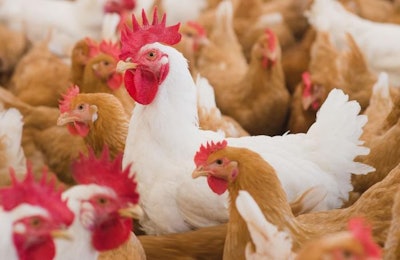
Moving to a slower growing broiler breed is more about improving the quality of the chicken than making a statement on genetics, according to the president of Bell & Evans.
In an interview, Bell & Evans President and Owner Scott Sechler explained the reasoning behind his company’s November 28, 2017, announcement that it’s transitioning all of its farms to a slower growing breed.
Sechler said the brand, based in Fredericksburg, Pennsylvania, prides itself on quality and the move was more about supplying a “grade A” bird than anything else. It plans on investing more than $75 million in the new breed during the first five years. WATT Global Media’s 2017 Top Broiler Companies rankings placed the company – Farmers Pride Inc. – at 24th with 3.5 million pounds ready-to-cook chicken produced on a weekly basis.
Details of the roll out
Sechler said he’s currently bringing eggs over from European breeders. By November 2018, he plans on fully transitioning all of the company’s breeders to the Das Klassenbester breed. New breeder and pullet houses for the birds are currently being built.
The first pullets of the new breed were placed in May 2017. In December 2017, the transition will begin as flocks are started and eggs are brought in from European breeders. By the end of January 2018, he expects the first of the new breed will be processed and arriving on the market.
While he declined to discuss the specifics of where the breed is coming from and which company is furnishing the genetics, he said it’s a closer match to the genetics of a decade prior. In some cases, the company has secured 100 percent of the available breeding stock to ensure a continuous supply going forward.
Bell & Evans’ liveweight averages 5.6 pounds at 41 days. The new breed will take 47 to 50 days, 15 percent longer, to reach the average liveweight. In a press release, the company said it plans on spending $14 million on additional feed per year due to the change.
Sechler said he doesn’t expect prices will change with the breed. Bell & Evans already gets higher prices than anyone else in the country. Feed costs will increase, but he thinks any losses will be made up if he’s able to sell more high-quality products. The company last raised prices almost a decade ago and a price increase is not planned to offset the higher costs associated with the new breed.
The Grade A bird
Sechler said he still remembers the birds that were around 15 years ago and he’s trying to turn the clock back to then in terms of genetics. While feed conversion improved since 2000, he said quality declined.
For years, he’s worked with breeder companies to get what he called a “grade A” chicken – a bird that looks good before you cook it. Bell & Evans is a leading provider of whole birds, not including rotisserie, at the retail level. Sechler said whole chickens makes up about 30 percent to 40 percent of his market. His consumers prefer a whole bird for its greater culinary potential.
Sechler said he’s not referring to Grade A as meeting the U.S. Department of Agriculture’s definition but rather that it’s the highest-quality product available. The USDA Food Safety and Inspection Service describes the Grade A packaging label as signifying “the poultry products are virtually free from defects such as bruises, discolorations, and feathers. Bone-in products have no broken bones. For whole birds and parts with the skin on, there are no tears in the skin or exposed flesh that could dry out during cooking, and a good covering of fat under the skin.”
The FSIS notes that Grade A is the only grade likely to be seen at retail level.
“I’ll give up feed conversion, I’ll give up the fastness of growing,” Sechler said. “Everyone is worried about efficiency in the chicken industry in America and almost no one takes quality really seriously.”
Furthermore, modern genetics are pushing the animal to the edge, he said, and this new breed will experience lower mortality, less stress and better overall health than a conventional broiler breed.
Responses to criticism of slower growing birds
Slower growing chicken genetics promises to be a key issue the U.S. chicken industry will deal with in the coming years. Urged by activists, some food companies and retailers are signing onto to pledges to supply birds coming from slower growing genetic stock. Research backed by the National Chicken Council said the practice will bring considerable financial and ecological drawbacks if adopted on a national scale.
Sechler doesn’t follow the same reasoning. He said he doesn’t want to supply a poor quality item just because it’s a cheaper, faster growing bird. Modern genetics bring problems like woody breast. More weight on the shackle and better feed conversion doesn’t make up for those problems, he said.
Bell & Evans says a slower growing bird tastes better, too. He argues the customer didn’t ask for a faster growing bird – it was given to them by the industry – and they are willing to pay more for a higher quality product. He doesn’t need scientific proof the chicken tastes better, the consumer’s voice is proof enough.
“People don’t pay twice as much for something the second time if it isn’t better than the product they compare it with,” Sechler said.
Bell & Evans, a major supplier to Whole Foods Market, is also working under the Global Animal Partnership (GAP) standards. Sechler said the company is third party audited in accordance with the standards and is likely more involved with the program than any other chicken company.


















